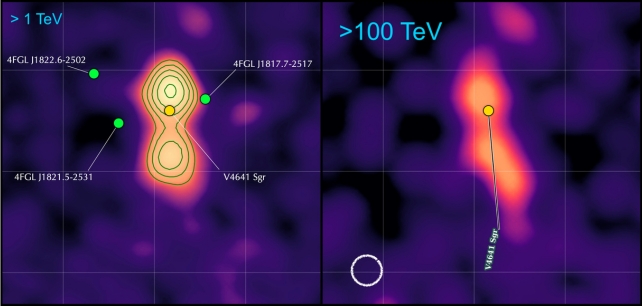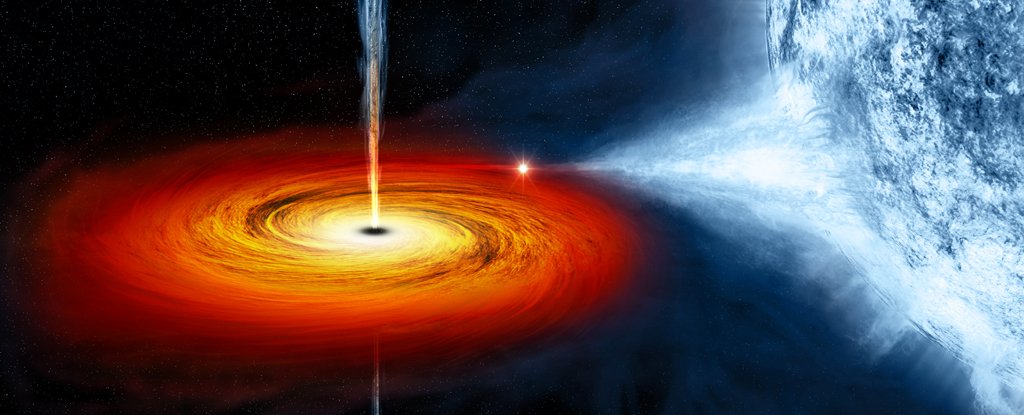Products You May Like
Scientists have long thought that the highest-energy gamma rays in space are forged in the intense furnaces of very active supermassive black holes, far, far away. But a new study has traced some of these high-energy photons to an object much closer to us.
V4641 Sagittarii is a system about 20,000 light-years from Earth, in the direction of the constellation Sagittarius. There, a black hole with the mass of about six Suns is slurping material off a giant star of about three solar masses – and producing intense radiation like a cosmic particle accelerator.
Astronomers have now detected photons from V4641 Sagittarii carrying energies of up to a staggering 200 teraelectronvolts (TeV). For reference, that’s 200 trillion times more energy than visible light, and among the highest-energy photons you’ll find out in space.
Gamma rays around this energy level are known to zip around the cosmos, but scientists thought they mostly originated in quasars – bright galactic cores, in which supermassive black holes release huge amounts of energy as they messily chow down on in-falling gas.
V4641 Sagittarii is what’s known as a microquasar, and as the name suggests, it kind of functions like a mini version of a regular quasar. The black hole is smaller, the matter source is smaller, and the radiation they emit is smaller. Or at least, that’s what conventional thinking told us.
“Photons detected from microquasars have usually much lower energies than those from quasars,” says Sabrina Casanova, of the Institute of Nuclear Physics Polish Academy of Sciences (IFJ PAN).
“Usually, we are talking about values of the order of tens of gigaelectronvolts. Meanwhile, we have observed something quite incredible in the data recorded by the detectors of the [High-Altitude Water Cherenkov] observatory: photons coming from a microquasar lying in our galaxy, and yet carrying energies tens of thousands of times higher than typical.”

Located on the side of the extinct Sierra Negra volcano in Mexico, the HAWC gamma-ray observatory is designed to pick up particularly high-energy particles streaming in from space. To do so, it’s made up of 300 big steel tanks, full of purified water.
The idea is, when these high-energy particles enter a tank, they set off a cascade of other particles that travel through the water faster than light does. This creates a flash of light called Cherenkov radiation, which is essentially the electromagnetic version of a sonic boom.
Sensitive detectors lining the inside of the tanks pick up these flashes, and allow scientists to work backwards to figure out what type of charged particle set it off, and which direction it came from.
HAWC can see 15 percent of the sky at any given time, and will scan two-thirds of the whole sky every 24 hours, building up a kind of cosmic map. It was in one of these maps that V4641 Sagittarii appeared as an unexpected bright spot of gamma rays.
“While reviewing the sky maps in search of my next project, I noticed a region five degrees away from our galactic plane with bright emissions that had not been visible in previous datasets,” says physicist Xiaojie Wang.
“No gamma-ray source has been identified nor analyzed in this region – so I seized the opportunity and led the analysis.”

On closer inspection, V4641 Sagittarii was found to be the source of these ultra high-energy gamma rays. Other microquasars, like SS 433, have previously been detected throwing off photons at energies of over 25 TeV, but V4641 Sagittarii is next-level: it was producing radiation on par with regular quasars, a feat previously thought impossible.
The new discovery gives astronomers a better understanding of not just cosmic radiation, but quasars themselves. The physics around those huge objects plays out in slow motion, over millions of years – but microquasars do similar processes on timescales of days. They’re like natural simulators.
The research was published in the journal Nature.
